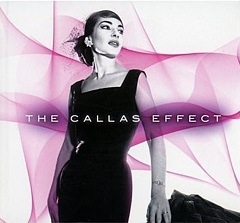
Only because I am a member of the You Can Never Have Too Much Callas School of Opera Listening can I recommend EMI’s new release The Callas Effect. The beautifully packaged production
is the size of a small paperback book and consists of two CDs with 29 arias sung by Callas plus a new 70-minute DVD showing some details of her life and artistry, focusing on her work with the Royal Opera House. The package also contains a detailed and moving essay by Ira Siff plus translations of the texts of all the recorded arias.
The trouble is, it’s all been done before with more detail and insight. While this package might be an excellent holiday gift for someone with a burgeoning interest in the work of Maria Callas, anyone with even a rudimentary knowledge of La Divina will likely feel a distinct sense of déjà vu. Virtually all the CD selections are recycled from the ‘80’s release “La Divina” (which I received as a gift on cassette and played repeatedly until it literally disintegrated) plus a smattering from other previous albums. The DVD is a pale shadow of the earlier released John Ardoin film and doesn’t even match the A&E television production Callas, Life and Art that has been available for many years.
Still, the CDs are well worth a new visit. There are a few selections here that I was only marginally familiar with, including a gorgeous “Dov’e l’indiana bruna” from Lakme under the master Serafin where Callas almost seems to employ three different voices to illuminate the changing moods of this piece.
Later there is an astonishingly fresh-voiced “Je suis Titania” from Mignon, with Callas tossing off the high-flying coloratura with utter ease, while bringing an ebullience and joy to the piece that made it much more than an excuse for soprano pyrotechnics. To hear the voice shift from this aria to Lady Macbeth’s “La luce langue” and Turandot’s “In questa reggia” is to remember in amazement the apocryphal story of Serafin demanding that Callas sing Elvira in I Puritani in a week while she still had two more Brunnhildes to get through. Was there in our time another artist who could sing with such versatility?
Even the familiar pieces hold wonder. Who could forget the lightly touched “mmmmm-ma” in “Una voce poco fa”, the interpolated high E at the end of the Vespri Bolero, the frenzy of bloodlust she conveys with the repeated “Cadra!” in “La luce langue,” and the sense of deep, unfulfilled longing that only she could bring to “Ah fors’e lui”, “Vissi d’arte”, “Tu che le vanita”, and “La mamma morte.” The phrasing, the enormous range of vocal colors, the very personal touch she gave to every lyric are all on abundant display here, fueled by her phenomenal work ethic and studied musicianship.
The one real misstep seems to me a most peculiar rendition of Elvira’s “Mi tradi” from Don Giovanni. While the notes and the phrasing are there, Callas barrels through it in a very verismo-ish way. It sounds more like Santuzza than a Mozart heroine.
The DVD is the least interesting element of The Callas Effect. The familiar film of the 1964 Covent Garden Tosca Act II is hauled out yet again, and the only other footage shown is the equally familiar 1962 concert. The DVD commentary issues from a variety of Royal Opera folk, as well as some completely random people labeled as “Opera Connoisseurs” who provide little insight and much fawning. Mirella Freni and Joyce diDonato add rather general comments.
There is nothing new here, except an interesting story by director John Copley about Callas teaching him new things about the score of Il Trovatore; what he called a cadenza, Callas shows is actually a vital part of the aria itself. There is also an interesting focus on Callas’ acting work and how she used stillness and economy of gesture to tremendous effect. The most valuable comments come from Tito Gobbi’s daughter Cecilia, who provides some very personal stories. Still, this DVD is definitely Divina 101, and most of the frequently twee commentary runs the gamut from annoying to irritating. Give it to a newbie.
The best part of The Callas Effect is that it serves as another reminder of how the combination of utter dedication and musical genius made Callas the premiere singing artist of the twentieth century. The worst part is the feeling that this rather unnecessary release is a marketing ploy to keep the Callas mystique alive through the EMI catalogue, all of which is documented in the accompanying booklet.


























Comments